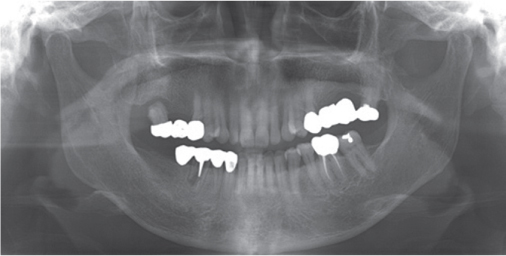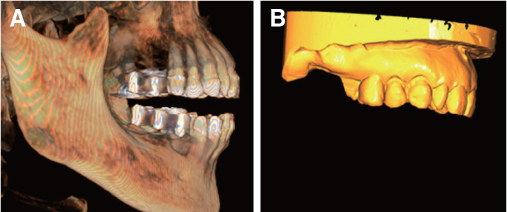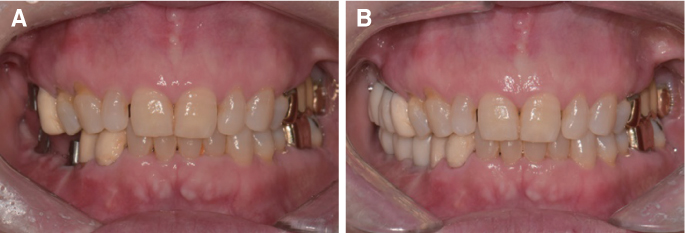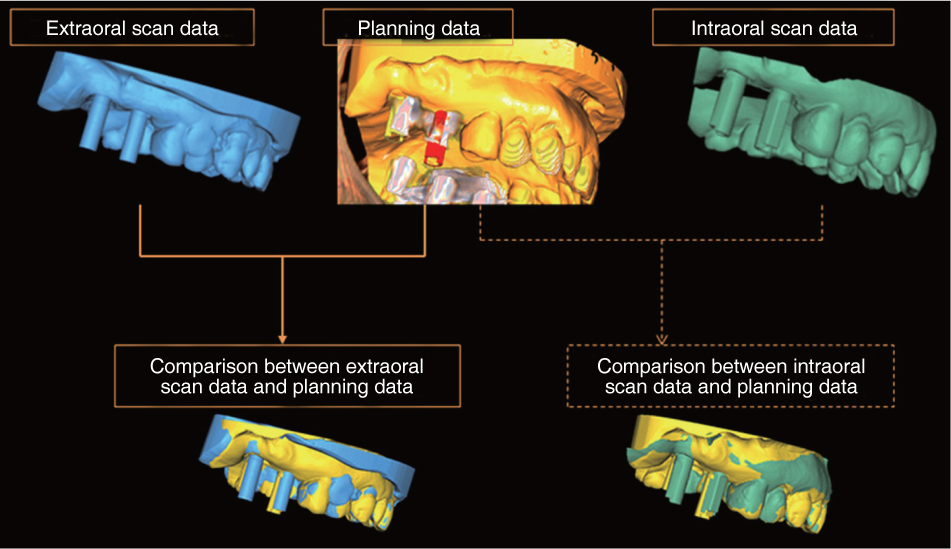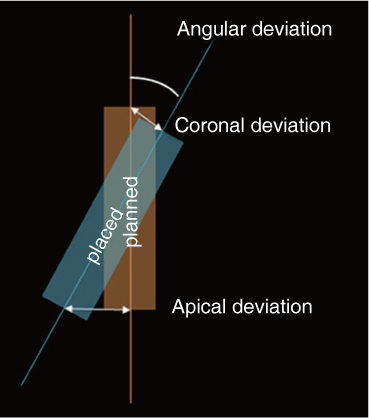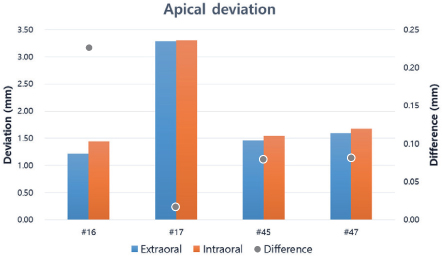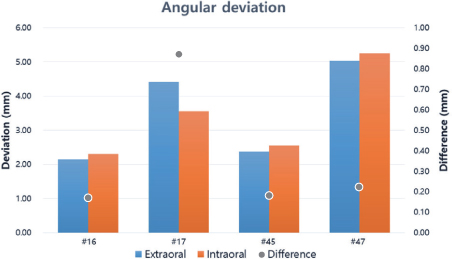J Korean Acad Prosthodont.
2019 Apr;57(2):150-159. 10.4047/jkap.2019.57.2.150.
An assessment of accuracy of half-guided implant surgery using implant surgical guide: A case report
- Affiliations
-
- 1Dental Research Institute and Department of Prosthodontics, School of Dentistry, Seoul National University, Seoul National University Dental Hospital, Seoul, Republic of Korea. proskwon@snu.ac.kr
- 2Department of Prosthodontics, Dental Hospital, St. Mary's Hospital of Catholic University of Korea, Seoul, Republic of Korea.
- KMID: 2444184
- DOI: http://doi.org/10.4047/jkap.2019.57.2.150
Abstract
- Nowadays, dental implant is one of the widely used treatment options for edentulous patients. Recently, a method of improving the accuracy of implant surgery using an implant surgical guide has been introduced and widely used in order to accurately place the implant in a proper position. Full-guided and half-guided implant surgery can be distinguished according to the level of surgical guide application during the implant surgery. It is true that full-guided implant surgery exhibits higher accuracy, but half-guided implant surgery is often performed in a clinical situation due to the factors such as the circumstances of the operation. A partially edentulous patient who lost teeth due to tooth fracture and periodontal disease was treated using implant and fixed prosthesis. Half-guided implant surgery was performed using an implant surgical guide during implant surgery, the accuracy of implant placement was analyzed.
MeSH Terms
Figure
Reference
-
1. Buser D, Martin W, Belser UC. Optimizing esthetics for implant restorations in the anterior maxilla: anatomic and surgical considerations. Int J Oral Maxillofac Implants. 2004; 19:43–61.2. González-García R, Monje F. The reliability of cone-beam computed tomography to assess bone density at dental implant recipient sites: a histomorphometric analysis by micro-CT. Clin Oral Implants Res. 2013; 24:871–879.
Article3. Parsa A, Ibrahim N, Hassan B, van der Stelt P, Wismeijer D. Bone quality evaluation at dental implant site using multislice CT, micro-CT, and cone beam CT. Clin Oral Implants Res. 2015; 26:e1–e7.
Article4. Bover-Ramos F, Viña-Almunia J, Cervera-Ballester J, Peñarrocha-Diago M, García-Mira B. Accuracy of implant placement with computer-guided surgery: A systematic review and meta-analysis comparing cadaver, clinical, and in vitro studies. Int J Oral Maxillofac Implants. 2018; 33:101–115.
Article5. Vieira DM, Sotto-Maior BS, Barros CA, Reis ES, Francischone CE. Clinical accuracy of flapless computer-guided surgery for implant placement in edentulous arches. Int J Oral Maxillofac Implants. 2013; 28:1347–1351.
Article6. Kühl S, Zürcher S, Mahid T, Müller-Gerbl M, Filippi A, Cattin P. Accuracy of full guided vs. half-guided implant surgery. Clin Oral Implants Res. 2013; 24:763–769.
Article7. Papaspyridakos P, Gallucci GO, Chen CJ, Hanssen S, Naert I, Vandenberghe B. Digital versus conventional implant impressions for edentulous patients: accuracy outcomes. Clin Oral Implants Res. 2016; 27:465–472.
Article8. Esposito M, Grusovin MG, Willings M, Coulthard P, Worthington HV. The effectiveness of immediate, early, and conventional loading of dental implants: a Cochrane systematic review of randomized controlled clinical trials. Int J Oral Maxillofac Implants. 2007; 22:893–904.9. Gallucci GO, Benic GI, Eckert SE, Papaspyridakos P, Schimmel M, Schrott A, Weber HP. Consensus statements and clinical recommendations for implant loading protocols. Int J Oral Maxillofac Implants. 2014; 29:287–290.
Article10. Lee DH, An SY, Hong MH, Jeon KB, Lee KB. Accuracy of a direct drill-guiding system with minimal tolerance of surgical instruments used for implant surgery: a prospective clinical study. J Adv Prosthodont. 2016; 8:207–213.
Article11. Cassetta M, Stefanelli LV, Giansanti M, Di Mambro A, Calasso S. Accuracy of a computer-aided implant surgical technique. Int J Periodontics Restorative Dent. 2013; 33:317–325.
Article12. Vasak C, Watzak G, Gahleitner A, Strbac G, Schemper M, Zechner W. Computed tomography-based evaluation of template (NobelGuide™)-guided implant positions: a prospective radiological study. Clin Oral Implants Res. 2011; 22:1157–1163.
Article13. Vercruyssen M, Cox C, Coucke W, Naert I, Jacobs R, Quirynen M. A randomized clinical trial comparing guided implant surgery (bone- or mucosa-supported) with mental navigation or the use of a pilot-drill template. J Clin Periodontol. 2014; 41:717–723.
Article14. Arisan V, Karabuda ZC, Ozdemir T. Accuracy of two stereolithographic guide systems for computer-aided implant placement: a computed tomography-based clinical comparative study. J Periodontol. 2010; 81:43–51.
Article15. Cassetta M, Giansanti M, Di Mambro A, Calasso S, Barbato E. Accuracy of two stereolithographic surgical templates: a retrospective study. Clin Implant Dent Relat Res. 2013; 15:448–459.
Article16. Valente F, Schiroli G, Sbrenna A. Accuracy of computer-aided oral implant surgery: a clinical and radiographic study. Int J Oral Maxillofac Implants. 2009; 24:234–242.17. Fluegge T, Att W, Metzger M, Nelson K. A novel method to evaluate precision of optical implant impressions with commercial scan bodies-an experimental approach. J Prosthodont. 2017; 26:34–41.
Article18. Shimizu S, Shinya A, Kuroda S, Gomi H. The accuracy of the CAD system using intraoral and extraoral scanners for designing of fixed dental prostheses. Dent Mater J. 2017; 36:402–407.
Article19. Su TS, Sun J. Comparison of repeatability between intraoral digital scanner and extraoral digital scanner: An in-vitro study. J Prosthodont Res. 2015; 59:236–242.
Article
- Full Text Links
- Actions
-
Cited
- CITED
-
- Close
- Share
- Similar articles
-
- Clinical Precautions for Implant Placement using Computer-guided Implant Surgical Guide: A Systematic Review
- Implant-supported milled bar overdenture with two implant surgical guides
- The Accuracy of Implant Placement According to the Height of the Surgical Guide Hole
- Accuracy of digital surgical guides for dental implants
- Accuracy of Surgical Robot System Compared to Surgical Guide for Dental Implant Placement: A Pilot Study


